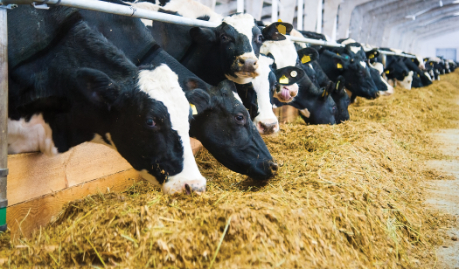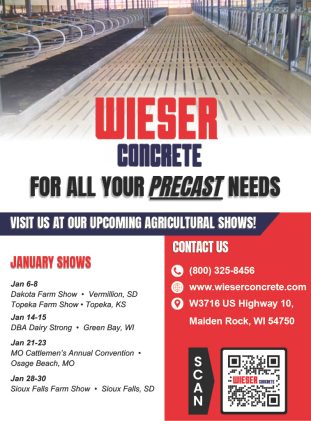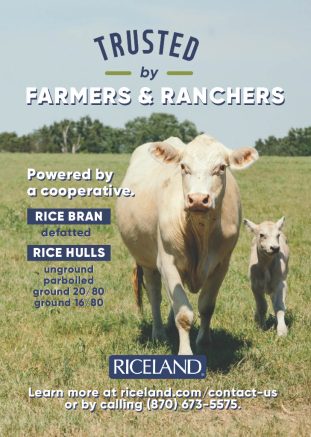Feed Additives for Dairy Cows

Feed Additives for Dairy Cows
There are a number of feed additives commonly in use in dairies. Scott E. Poock, DVM, DABVP, Associate Extension Professor, University of Missouri, says that there are some regulations regarding what can be fed, but there are more regulations for what is fed to lactating cows, versus non-lactating cows. “If they eat something that ends up in the milk, this would determine the difference,” he explains.
Feed additives are for many reasons—to keep cattle healthy, enable the rumen to function optimally, increase milk production, etc. They also have to be cost effective; no dairy wants to feed something that costs more than the benefits seen.
“Probably the most common additive we see in dairy cow rations is monensin (Rumensin). There are many advantages to using Rumensin, beyond just coccidia control and feed efficiency. It stimulates more propionic acid production, which is a major fuel source for the cow. You can help her through the transition period because she is producing more propionic acid, which means she’s producing more glucose for her body,” Poock says.
Ionophores are very useful; monensin has been approved in cattle for a long time in the U.S. for increased feed efficiency. It also helps reduce incidence of ketosis because of how ionophores function in the rumen.
Dairies often add in something for fly control. “There is a product called ClariFly® Larvicide that is a feedthrough,” says Poock. Flies spread disease and are irritating to cattle on a dairy operation, as well as to the people that work there. Because of the confined nature of a dairy, ClariFly® Larvicide can be part of an integrated pest management (IPM) program for effectively controlling fly populations. To be fully effective however, it is important to start ClariFly® Larvicide in milk and milk replacer at the calf stage and continue it through adulthood. Otherwise, the flies that start in calf pens or hutches can quickly spread.
The larvicide product is harmless to cattle; it passes through the digestive system of the animal, and then stays in the fresh manure where flies lay their eggs. The active ingredient then prevents the larvae of house flies, stable flies, face flies, and horn flies from developing into adults, interrupting the life cycle.
Poock helps plan rations for dairy cattle, and another common additive is sodium bicarbonate, especially for cattle on a higher corn silage diet. “This can help regulate the pH in the rumen,” Poock explains.
“This is especially important in the summer when hot weather depresses appetite. If the intake goes down a little, you need to make what they eat a little more energy dense. Yet this increases the potential for acidosis, so the bicarb is very important at this point,” he says.
Sodium bicarbonate acts as a buffer for the rumen, creating a better environment for the important microbes to survive. The sodium helps drive water intake. This helps speed the rate of passage of feed in the gut. This is very helpful for the lactating cow; as water intake increases, more quickly the ingesta that goes through the gut. The cow can eat more, and ultimately absorb more nutrients and produce more milk.
Yeast and probiotics are also commonly in use at dairy rations, for better animal health. Direct-fed microbial products like yeast and yeast cultures can aid digestibility of feed, and also appear to be beneficial in heat stress situations. There is some use for these in lactating cows. Other direct-fed microbials include certain enzymes, prebiotics, probiotics, etc. These all tend to benefit gut health.
“Supplying these to dairy cows will probably become even more common in the future,” says Poock. I attended a veterinary medical meeting earlier this year that included a presentation on this topic. On down the road, the therapy for various diseases will probably include the use of probiotics. At some point we will learn that certain bacteria in the gut and in the body can be beneficial in dealing with various diseases and problems, so part of the therapy will include adding these to the diet, to help the body get back to normal,” he says.
“The use of probiotics can be helpful across the board—not just in the cows but also in calves that are receiving milk or milk replacer, and all the way through their lives and as lactating cows.” These products can help keep the gut functioning optimally.
There is some indication from research that adding yeast and yeast cultures to calf diets can promote production of immunoglobulin A in the small intestine, which will help fight pathogenic bacteria in those calves.
As the calves get older and the rumen develops, yeasts and other direct-fed microbial products can be beneficial. Ruminant animals depend on microbes in the rumen to break down and digest forage, and the balance of those microbe populations is crucial. If the animal cannot digest and process feed optimally, that animal cannot perform optimally. “We are not only feeding the cow; we are feeding the microbes in her rumen, and this is very important.” Poock says.
Mycotoxin binders are commonly of use in dairies, due to the risk for molds in certain forages. The mycotoxin binders are good insurance and could help avoid a lot problems.
Since many dairies utilize silage as part of the ration, it is also important to make sure the silage is put up correctly for proper fermentation, so that it is optimum not only for nutrients but for rumen health. There are various types of silage inoculants that can be added to enhance fermentation. Proper fermentation will lead to increased intakes, digestibility, and thus performance of the cattle.
Trace minerals are also very important to include in the diet. “Although these are found in small amounts, they are important for the immune system (selenium, copper, zinc, etc.) and foot health (zinc and the vitamin biotin). Usually, the organic form of these minerals are more absorbable but add to the cost of feeding them,” he says.
Many dairies now use chelates, replacing some of the standard minerals in a mineral mix. Chelates aid in absorption of some of the specific minerals and there is good research data on that. People often use zinc methionine.
Some dairies also use vitamin supplements. Research is showing that the nicotinic acid form of niacin helps improve colostrum quality and increase some of the components in colostrum that affect gut development in the calf. There is also some data showing that it may help reduce heat stress. Biotin is another vitamin that some dairies utilize. It has been shown to improve hoof health.
October 2023
By Heather Smith Thomas.
If you would to read another article around LRP Matting and their great quality product
F0r Cattle Industry News:
If you are an Outdoor Enthusiast, The Iowa Sportsman is the place for you.




